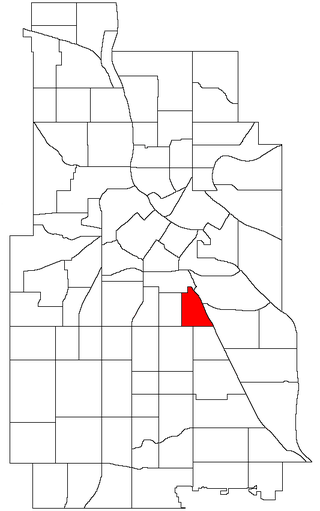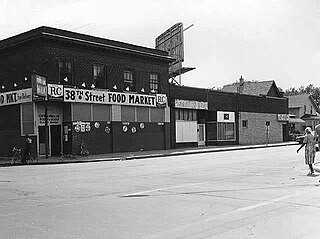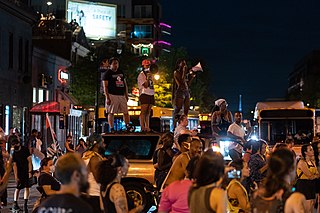
The Rocky Mountain Arsenal was a United States chemical weapons manufacturing center located in the Denver Metropolitan Area in Commerce City, Colorado. The site was completed December 1942, operated by the United States Army throughout the later 20th century and was controversial among local residents until its closure in 1992.

Orica Limited is an Australian-based multinational corporation that is one of the world's largest providers of commercial explosives and blasting systems to the mining, quarrying, oil and gas, and construction markets, a supplier of sodium cyanide for gold extraction, and a specialist provider of ground support services in mining and tunnelling.

Lake Street is a major east-west thoroughfare between 29th and 31st streets in Minneapolis, Minnesota United States. From its western most end at the city's limits, Lake Street reaches the Chain of Lakes, passing over a small channel linking Bde Maka Ska and Lake of the Isles, and at its eastern most end it reaches the Mississippi River. In May 2020, the Lake Street corridor suffered extensive damage during local unrest following the murder of George Floyd. In August of the same year, city officials designated East Lake Street as one of seven cultural districts to promote racial equity, preserve cultural identity, and promote economic growth.

The Southwest LRT is an under–construction 14.5-mile (23.3 km) light rail transit corridor in Hennepin County, Minnesota, with service between Minneapolis and Eden Prairie. The estimated one-way travel time from Southwest Station in Eden Prairie to Target Field Station in Minneapolis is 32 minutes. The Southwest LRT will extend through St. Louis Park, Hopkins and Minnetonka along the route. Major locations on the line will include Bde Maka Ska, Cedar Lake, the Walker Art Center, the Minneapolis Sculpture Garden and Target Field in downtown Minneapolis.
The Greenpoint oil spill is one of the largest oil spills ever recorded in the United States. Located around Newtown Creek in the Greenpoint neighborhood of Brooklyn, New York City, between 17 and 30 million US gallons of oil and petroleum products have leaked into the soil from crude oil processing facilities over a period of several decades. The spill was first noticed in 1978, and soil vapor tests were still reported as returning positive in 2008.

U.S. Bank Stadium is an enclosed stadium located in downtown Minneapolis, Minnesota. Built on the former site of the Hubert H. Humphrey Metrodome, the indoor stadium opened in 2016 and is the home of the Minnesota Vikings of the National Football League (NFL); it also hosts early season college baseball games of the University of Minnesota Golden Gophers.
The environmental issues on Maury Island are linked to broader Puget Sound environmental issues, which include concerns regarding declining salmon and forage fish populations, degrading critical marine and shoreline habitats, and threatened species such as the Orca.

The Milwaukee Avenue Historic District is a historic district in the Seward neighborhood of Minneapolis. The district comprises two city blocks of small homes on quarter-sized lots. These houses were built between 1884 and 1890 by William Ragan, a Minneapolis real estate speculator. Built for lower-income residents, the houses had deteriorated in condition by the end of World War II, and by the 1970s, were planned for demolition. A group of residents and concerned citizens fought to save the houses, eventually leading to their inclusion on the National Register of Historic Places and the federal protection and rehabilitation that comes with the designation. Today, the houses sit along a bike- and pedestrian-friendly mall on which motor traffic is prohibited.
The Escambia Wood Treating Company (ETC) site is located at 3910 Palafox Highway, northeast of the intersection of Fairfield Drive in Pensacola, Florida, and is in a mixed industrial, commercial, and residential area. The site includes the 26-acre property of the former wood preserving facility and over 60 acres of nearby neighborhoods. The facility was in operation from 1942 until 1982, then abandoned by the owner in 1991. During its operation, ETC treated utility poles, foundation pilings, and lumber with creosote and pentachlorophenol. Production byproducts were dumped into on-site, unlined containment pits where they seeped into the surrounding soil and groundwater. Escambia Wood Treating Company
Lead contamination in Oakland represents a serious and persistent public health threat. Lead contamination in modern Oakland comes from three primary sources: remnants from previous industry, deposits from leaded gasoline, and paint chips from leaded paints. Significant portions of the City of Oakland, California have soil lead levels far in excess of 400 ppm, the level at which the US EPA suggests remedial action be taken, and far higher than 80 ppm, the level at which California’s Office of Environmental Health Hazard Assessment suggests action should be taken. Not all areas of Oakland are affected equally: West Oakland's contamination is especially severe, particularly near the former Oakland Army Base, and many of Oakland's poorer neighborhoods also suffer disproportionately.

Groundwater pollution occurs when pollutants are released to the ground and make their way into groundwater. This type of water pollution can also occur naturally due to the presence of a minor and unwanted constituent, contaminant, or impurity in the groundwater, in which case it is more likely referred to as contamination rather than pollution. Groundwater pollution can occur from on-site sanitation systems, landfill leachate, effluent from wastewater treatment plants, leaking sewers, petrol filling stations, hydraulic fracturing (fracking) or from over application of fertilizers in agriculture. Pollution can also occur from naturally occurring contaminants, such as arsenic or fluoride. Using polluted groundwater causes hazards to public health through poisoning or the spread of disease.

Nekima Valdez Levy Armstrong is an American lawyer and social justice activist. She was president of the Minneapolis chapter of the NAACP from 2015 to 2016. She has led a variety of organizations that focus on issues of racial equality and disparity in the Minneapolis–Saint Paul area.

East Phillips is a neighborhood within the Phillips community in Minneapolis. Its northern boundary runs along East 24th Street from Bloomington Avenue to 17th Avenue South, then runs along East 22nd Street from 17th Avenue South to Little Earth Trail and Hiawatha Avenue. Its other boundaries are Hiawatha Avenue to the east, East Lake Street to the south, and Bloomington Avenue to the west. The Phillips community has only been subdivided into smaller neighborhoods within the last couple years; the boundaries of East Phillips were officially designated on December 23, 2005. As this change has been fairly recent, most residents still refer to the area as just "Phillips". The neighborhood also features the Little Earth residential community.

Exide is one of the world's largest producers, distributors and recyclers of lead-acid batteries. Lead-acid batteries are used in automobiles, golf carts, fork-lifts, electric cars and motorcycles. They are recycled by grinding them open, neutralizing the sulfuric acid, and separating the polymers from the lead and copper. In the US, 97 percent of the lead from car batteries is recycled - which is the highest recycling rate for any commodity. Most states require stores to take back old batteries.

38th Street is a major east-west roadway in the U.S. city of Minneapolis and an officially designated cultural district in the Powderhorn community. The area developed into a residential zone when the Chicago Avenue street car line was extended to East 38th Street in 1880. Since the 1930s, the area has featured many Black-owned businesses, and the surrounding neighborhoods have had distinct histories from other neighborhoods in Minneapolis due to racial settlement patterns that concentrated Black residents there.

The U.S. city of Minneapolis featured officially and unofficially designated camp sites in city parks for people experiencing homelessness that operated from June 10, 2020, to January 7, 2021. The emergence of encampments on public property in Minneapolis was the result of pervasive homelessness, mitigations measures related to the COVID-19 pandemic in Minnesota, local unrest after the murder of George Floyd, and local policies that permitted encampments. At its peak in the summer of 2020, there were thousands of people camping at dozens of park sites across the city. Many of the encampment residents came from outside of Minneapolis to live in the parks. By the end of the permit experiment, four people had died in the city's park encampments, including the city's first homicide victim of 2021, who was stabbed to death inside a tent at Minnehaha Park on January 3, 2021.

Civil unrest began in the Uptown district of the U.S. city of Minneapolis on June 3, 2021, as a reaction to news reports that law enforcement officers had killed a wanted suspect during an arrest. The law enforcement killing occurred atop a parking ramp near West Lake Street and Girard Avenue. Police fired several rounds, killing the person at the scene. In an initial statement about the encounter, the U.S. Marshals Service alleged that a person failed to comply with arresting officers and produced a gun. Crowds gathered on West Lake Street near the parking ramp soon afterwards as few details were known about the incident or the deceased person, who was later identified as Winston Boogie Smith, a 32-year-old black American man.

George Floyd Square, officially George Perry Floyd Square, is the commemorative street name for the section of Chicago Avenue in the U.S. city of Minneapolis from East 37th Street to East 39th Street. It is named after George Floyd, a Black man who was murdered there by Minneapolis police officer Derek Chauvin on May 25, 2020. The streetway and memorial site is centered at the 38th and Chicago intersection.
Hyde Park is a district in the American city of Augusta, Georgia, developed in the 1940s. Due to the low value of the land due to swamp, it was predominantly populated by African American sharecroppers from nearby rural areas. It was the subject of a $1.2 million United States Environmental Protection Agency (EPA) study of the air, groundwater, and soil in the area to determine the health risks from environmental contaminants. The area was divided into five neighborhoods with two of the five finding high levels of arsenic, chromium, and dioxin in the soil and groundwater. Significant levels of PCBs and lead were found in all five neighborhoods. Despite this, officials determined that the chemicals found in the area did not constitute great risk to health.















